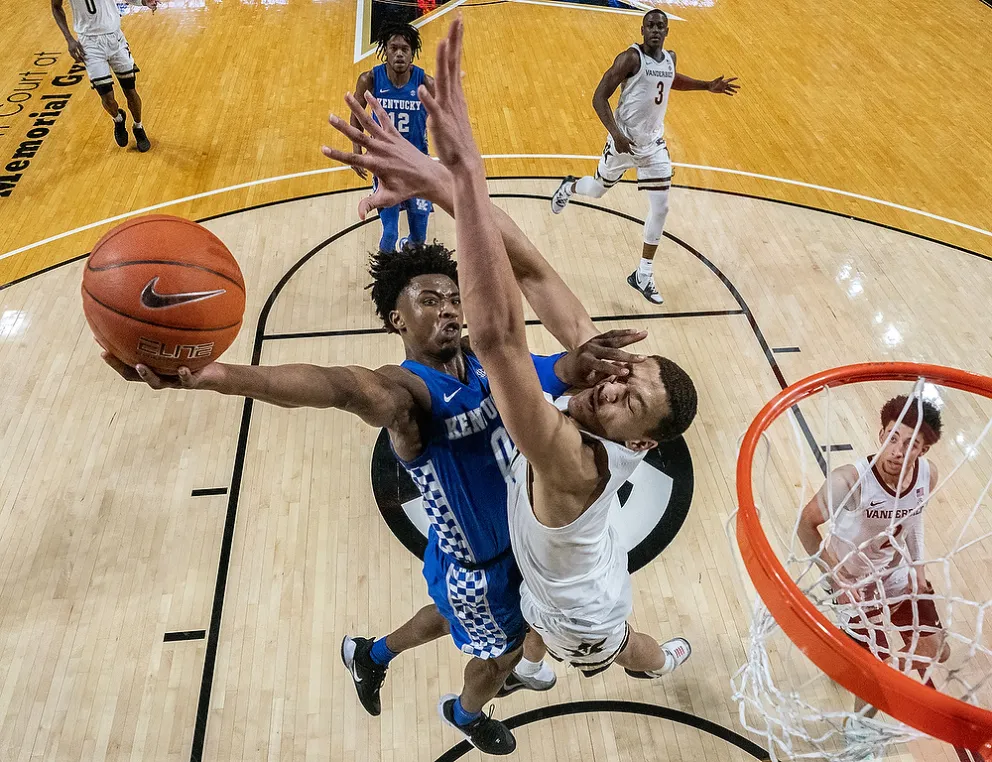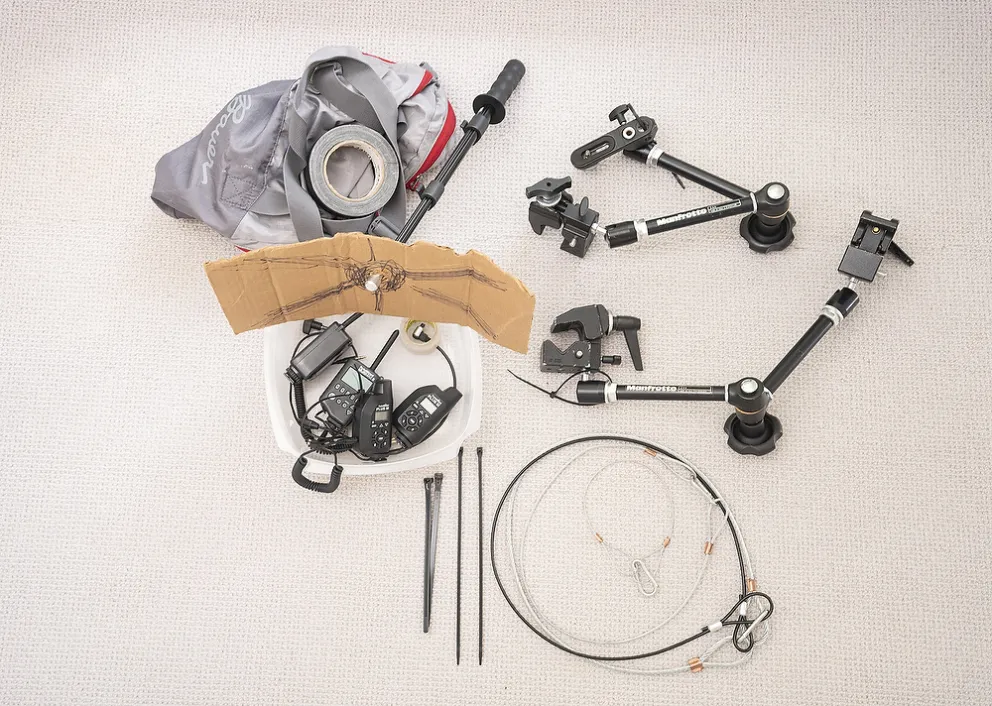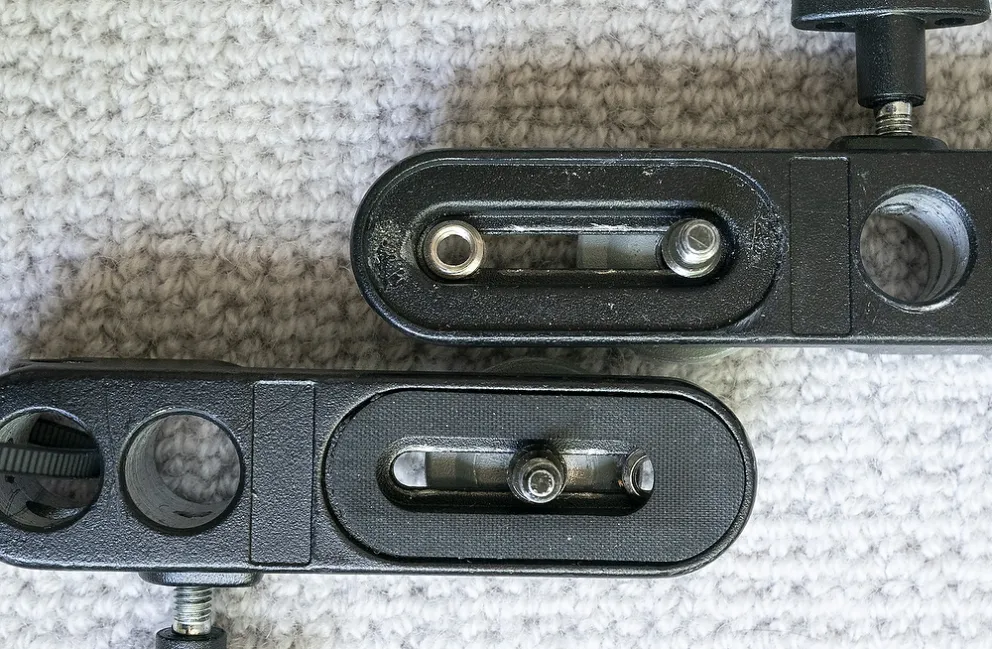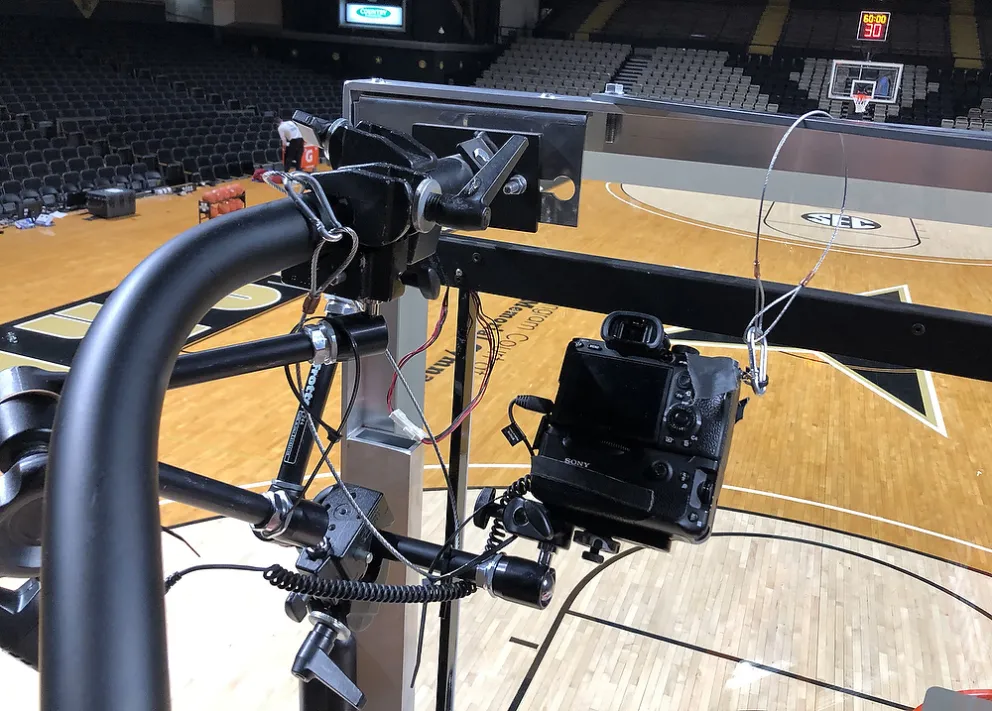
(text and photos by Joe Howell) Joe Howell is Senior Photographer, Marketing Solutions at Vanderbilt University. His sports action photo "Eye Poke" was voted Best in Show in the March 2020 Monthly Image Competition. As many know, backboard remotes in college hoops seem to be magnets for attention, both positive and negative. For that reason this MIC Q&A is modified slightly from the usual format: This article will go more into the nuts-and-bolts of the process than usual. Joe describes the considerable prep work, hardware and rules knowledge required to successfully pull off a backboard remote.
Quick tech stuff—camera model, focal length, exposure data, lighting used (if any):
•Sony A7RIII triggered remotely with a Pocket Wizard
•16-35mm lens at 16mm
•1/1000 @ f5, 6400 ISO
Briefly go through the process...wait, actually, please don't be brief!
There is discussion on the Facebook page about the permissibility of this photo due to the camera position and NCAA rules. Behind the backboard remote cameras are allowed (emphasis added), and I will discuss this at the end.
Remote camera work should be fun, the results can be stunning, and that is what keeps every photographer motivated to do it. However, I often find that setting up remotes is time consuming, with low–yield results, and requires more equipment that a lot of photographers have available. Do not rely on remote cameras as your main tool, while providing coverage. The camera in your hands should be your primary tool.
Safety is the most important factor when doing remote work. For success do your homework ahead of time by practicing setting up a remote in your office, or at home, prior to using a remote at an event. Additionally, work with your event/athletic staff to go on location and set up days before the event. This will help you to be confident and comfortable with setting up the remote. Go ahead figure out exactly where you want to put the remote, then mark the spot with tape. Because you are prepared you can walk in on the day of the event ready to go.
Process:
I will give you my process for how I do remotes at Vanderbilt. I am not saying this is the “right way” to do a remote. The setup and use of remotes is up to you, so use your best judgement and again, safety is the most important factor.
The basic equipment you will need:
•Two magic arms
•Three super clamps
•Baseplate/camera platform (with rubberized grip) to hold camera
•Gaffer's tape
•Zip ties
•Safety cables
•Remote – transmitter and receiver. I use pocket wizards and they can be set to either setting
•Leatherman tool
•Make sure you have new or reasonably charged batteries in your trigger kit and camera
•Focusing target

Joe keeps all his remote equipment together in one bag.
I show up three hours prior to tipoff – for me this is the sweet spot time-wise. I find that players start straggling out about two hours and thirty minutes prior to the game. The biggest reason I go early is the fact that I will not be rushed during my set up. When you are not in a hurry you tend to make less mistakes – safety first. I have a remote bag where I keep all I need for remotes, so that I am prepared and not searching for gear.
Prior to arriving I make sure everything is working, and I have the majority assembled and ready to go – minus minor adjustments. I make sure my camera has all of the proper settings. This includes shutter speed, ISO, color temperature and aperture. I turn off the monitor/viewing screen on the back of the camera, so that images don’t pop up for review. I use a large capacity memory card and format it. Furthermore, I make sure that my camera is set to power save time of 30 min (max setting for Sony). Another option is to use a prerelease cable. Both methods keep the camera awake, but if you do not have a prerelease cable you will need to remotely trigger your camera before 30 min time period expires. If not, your camera will go to sleep.

Use the magic arm baseplate with the rubber base!
After getting a ladder from facilities crew, I attach my camera to the camera base/baseplate connected to the magic arm. Make sure you have the rubber grip on your camera platform, because if you don’t the camera will not secure in place. This is followed by a series of steps. I remove anything that can fall off the camera. This includes my protective filter on my lens, eyepiece, and lens hood. If you keep the lens hood, make sure it is in the lock position and taped. Also, I tape the lens zoom ring at 16mm, based on past experience. I tape the motor drive to the camera, because earlier this year my camera and motor drive separated during warmups. It is amazing how much the basket and goal shakes when a ball is dunked. Warmups mean repeated dunking. This is reason you need a support arm for your camera.

Tape, safety cables, more tape, and more safety cables. Have we mentioned the #1 priority is safety?
Once I am at the top of the ladder, I attach the entire rig and position the camera. I get the camera as close to the glass as possible without touching, and I firmly tighten every knob. From here all of the safeties go on, and the pocket wizard is secured in place. Then I have someone hold a focusing target slightly to the front of the basket and approximately 8ft high to make sure that I have focus. Fifty-year-old eyes don’t work that well anymore, and even with a fresh pair of eyeballs you might as well be precise. When in need you can grab the sweat mop that the ball boys use, in place of a target. Tape the focus, fire your remote to make sure everything is working, check your safety features then you’re done. Grab a bite to eat and wait for the show to begin.
Permissions and Regulations:
At Vanderbilt, a photographer must ask the assistant director of communications in charge of men’s basketball for permission to mount a camera. If granted, then a remote can be set up with appropriate safety features. The camera cannot be inside the white square on the backboard or touching the glass. Finally, it is up to the discretion of the officiating crew.
NCAA sets policy for college athletics, which is implemented by the conferences and the individual schools. In the Southeastern Conference, the individual schools, namely the host institution, manage game management and rules of the conference. Here are some links and notes:
The SEC Constitution and Bylaws and Commissioner Regulations
SEC conference tournaments and championships guide
The NCAA Rules and Regulations outline the following (I am not sure that all of this is the most pertinent information regarding remotes, but these are the most specific references that I can find in the rules):
From Court and Equipment: “A pole attached to the shot clock that is used to mount a camera or a camera attached to the shot clock is permissible when the shot clock is recessed behind the backboard and does not interfere with a live ball nor does it affect the visibility of the shot clock.” (Item 11, pg. 13)
Also, from the NCAA, Rule 2: The Referee—Pregame Duties “Before the game starts, the referee shall: Article. 1. Inspect and approve all players’ uniforms and all equipment, including playing court, baskets, ball, backboards, and timers’/scorers signals.” (Rule 2, Section 5, pg. 31)
For postseason play, please see the second page of this NCAA document.
What (if anything) would you do differently if you could re-shoot this today?
I do not think I would do anything different on the shoot. I have made so many mistakes along the way to having a decent remote setup, that I feel pretty good about it.
Where do you look for inspiration, feedback and motivation?
For motivation I turn to UPAA. I love the work that people are producing, and I love the fact that we are all doing similar types of jobs – everything on the site is applicable to what I do daily at Vanderbilt. The best feedback I get is from fellow staff members, and a few good friends who are professional photographers.
What would your dream assignment be?
My dream assignment would be pretty extreme. Either photographing something like deep sea exploration or working with NASA to photograph astronauts working in space. Who knows maybe I could even be the first Space Force staff photographer(ha)!
_____________________________________________________
"I resigned from my job as the triangle player in the symphony. It was just one ting after another..." Email editor Matt Cashore with story ideas or feedback, mcashore@nd.edu. Follow UPAA on Instagram.